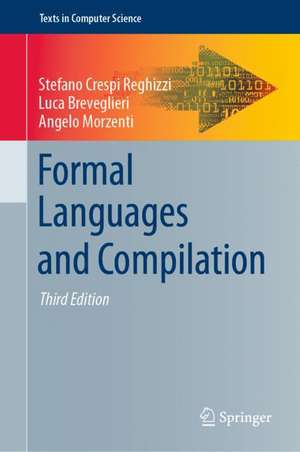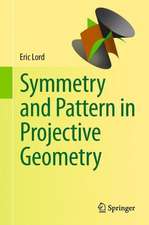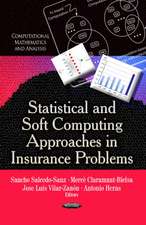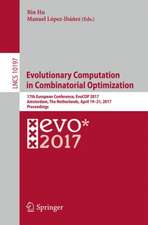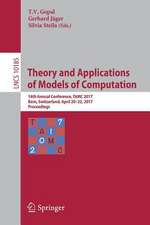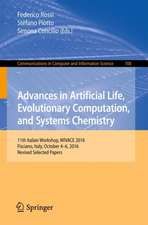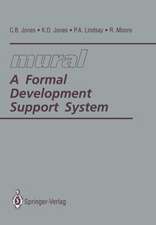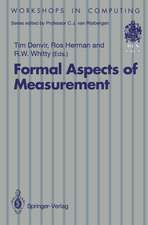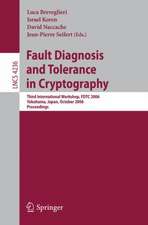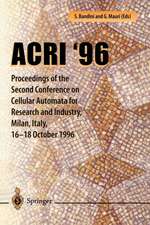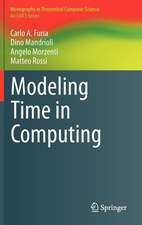Formal Languages and Compilation: Texts in Computer Science
Autor Stefano Crespi Reghizzi, Luca Breveglieri, Angelo Morzentien Limba Engleză Hardback – 6 mai 2019
This significantly updated and expanded third edition has been enhanced with additional coverage of regular expressions, visibly pushdown languages, bottom-up and top-down deterministic parsing algorithms, and new grammar models.
Topics and features: describes the principles and methods used in designing syntax-directed applications such as parsing and regular expression matching; covers translations, semantic functions (attribute grammars), and static program analysis by data flow equations; introduces an efficient method for string matching and parsing suitable for ambiguous regular expressions (NEW); presents a focus on extended BNF grammars with their general parser and with LR(1) and LL(1) parsers (NEW); introduces a parallel parsing algorithm that exploits multiple processing threads to speed up syntax analysis of large files; discusses recent formal models of input-driven automata and languages (NEW); includes extensive use of theoretical models of automata, transducers and formal grammars, and describes all algorithms in pseudocode; contains numerous illustrative examples, and supplies a large set of exercises with solutions at an associated website.Advanced undergraduate and graduate students of computer science will find this reader-friendly textbook to be an invaluable guide to the essential concepts of syntax-directed compilation. The fundamental paradigms of language structures are elegantly explained in terms of the underlying theory, without requiring the use of software tools or knowledge of implementation, and through algorithms simple enough to be practiced by paper and pencil.
| Toate formatele și edițiile | Preț | Express |
|---|---|---|
| Paperback (1) | 480.46 lei 6-8 săpt. | |
| SPRINGER LONDON – 23 aug 2016 | 480.46 lei 6-8 săpt. | |
| Hardback (1) | 605.87 lei 6-8 săpt. | |
| Springer International Publishing – 6 mai 2019 | 605.87 lei 6-8 săpt. |
Din seria Texts in Computer Science
- 20%
 Preț: 406.21 lei
Preț: 406.21 lei - 20%
 Preț: 675.36 lei
Preț: 675.36 lei - 20%
 Preț: 370.59 lei
Preț: 370.59 lei - 20%
 Preț: 474.58 lei
Preț: 474.58 lei - 20%
 Preț: 306.37 lei
Preț: 306.37 lei - 20%
 Preț: 366.94 lei
Preț: 366.94 lei - 20%
 Preț: 1244.39 lei
Preț: 1244.39 lei - 20%
 Preț: 503.88 lei
Preț: 503.88 lei - 20%
 Preț: 379.65 lei
Preț: 379.65 lei - 20%
 Preț: 444.93 lei
Preț: 444.93 lei - 20%
 Preț: 411.75 lei
Preț: 411.75 lei - 20%
 Preț: 305.31 lei
Preț: 305.31 lei - 17%
 Preț: 366.70 lei
Preț: 366.70 lei - 20%
 Preț: 409.70 lei
Preț: 409.70 lei - 20%
 Preț: 370.23 lei
Preț: 370.23 lei - 20%
 Preț: 411.53 lei
Preț: 411.53 lei - 20%
 Preț: 441.71 lei
Preț: 441.71 lei - 20%
 Preț: 423.53 lei
Preț: 423.53 lei - 20%
 Preț: 515.36 lei
Preț: 515.36 lei - 15%
 Preț: 637.58 lei
Preț: 637.58 lei - 20%
 Preț: 353.34 lei
Preț: 353.34 lei - 20%
 Preț: 356.82 lei
Preț: 356.82 lei - 20%
 Preț: 743.62 lei
Preț: 743.62 lei - 20%
 Preț: 663.45 lei
Preț: 663.45 lei - 20%
 Preț: 536.66 lei
Preț: 536.66 lei -
 Preț: 457.75 lei
Preț: 457.75 lei - 20%
 Preț: 181.92 lei
Preț: 181.92 lei - 20%
 Preț: 330.42 lei
Preț: 330.42 lei - 20%
 Preț: 358.24 lei
Preț: 358.24 lei -
 Preț: 385.84 lei
Preț: 385.84 lei - 20%
 Preț: 394.57 lei
Preț: 394.57 lei - 20%
 Preț: 344.76 lei
Preț: 344.76 lei - 20%
 Preț: 621.18 lei
Preț: 621.18 lei - 20%
 Preț: 350.86 lei
Preț: 350.86 lei - 20%
 Preț: 348.89 lei
Preț: 348.89 lei - 20%
 Preț: 339.95 lei
Preț: 339.95 lei - 20%
 Preț: 588.21 lei
Preț: 588.21 lei - 20%
 Preț: 199.57 lei
Preț: 199.57 lei - 20%
 Preț: 341.30 lei
Preț: 341.30 lei - 23%
 Preț: 726.94 lei
Preț: 726.94 lei - 20%
 Preț: 325.30 lei
Preț: 325.30 lei - 20%
 Preț: 595.80 lei
Preț: 595.80 lei - 20%
 Preț: 593.48 lei
Preț: 593.48 lei -
 Preț: 454.31 lei
Preț: 454.31 lei
Preț: 605.87 lei
Preț vechi: 757.34 lei
-20% Nou
Puncte Express: 909
Preț estimativ în valută:
115.95€ • 120.60$ • 95.72£
115.95€ • 120.60$ • 95.72£
Carte tipărită la comandă
Livrare economică 14-28 aprilie
Preluare comenzi: 021 569.72.76
Specificații
ISBN-13: 9783030048785
ISBN-10: 3030048780
Pagini: 510
Ilustrații: XIII, 499 p. 486 illus.
Dimensiuni: 155 x 235 x 33 mm
Greutate: 0.89 kg
Ediția:3rd ed. 2019
Editura: Springer International Publishing
Colecția Springer
Seria Texts in Computer Science
Locul publicării:Cham, Switzerland
ISBN-10: 3030048780
Pagini: 510
Ilustrații: XIII, 499 p. 486 illus.
Dimensiuni: 155 x 235 x 33 mm
Greutate: 0.89 kg
Ediția:3rd ed. 2019
Editura: Springer International Publishing
Colecția Springer
Seria Texts in Computer Science
Locul publicării:Cham, Switzerland
Cuprins
Introduction.- Syntax.- Finite Automata as Regular Language Recognizers.- Pushdown Automata and Parsing.- Translation Semantics and Static Analysis.
Notă biografică
The authors are Professors (Dr. Stefano Crespi Reghizzi is Emeritus Professor) of Computer Engineering at the Politecnico di Milano, Italy.
Textul de pe ultima copertă
This classroom-tested and clearly-written textbook presents a focused guide to the conceptual foundations of compilation, explaining the fundamental principles and algorithms used for defining the syntax of languages, and for implementing simple translators.
This significantly updated and expanded third edition has been enhanced with additional coverage of regular expressions, visibly pushdown languages, bottom-up and top-down deterministic parsing algorithms, and new grammar models.
Topics and features:
The authors are Professors (Dr. Stefano Crespi Reghizzi is Emeritus Professor) of Computer Engineering at the Politecnico di Milano, Italy.
This significantly updated and expanded third edition has been enhanced with additional coverage of regular expressions, visibly pushdown languages, bottom-up and top-down deterministic parsing algorithms, and new grammar models.
Topics and features:
- Describes the principles and methods used in designing syntax-directed applications such as parsing and regular expression matching
- Covers translations, semantic functions (attribute grammars), and static program analysis by data flow equations
- Introduces an efficient method for string matching and parsing suitable for ambiguous regular expressions (NEW)
- Presents a focus on extended BNF grammars with their general parser and with LR(1) and LL(1) parsers (NEW)
- Introduces a parallel parsing algorithm that exploits multiple processing threads to speed up syntax analysis of large files
- Discusses recent formal models of input-driven automata and languages (NEW)
- Includes extensive use of theoretical models of automata, transducers and formal grammars, and describes all algorithms in pseudocode
- Contains numerous illustrative examples, and supplies a large set of exercises with solutions at an associated website
The authors are Professors (Dr. Stefano Crespi Reghizzi is Emeritus Professor) of Computer Engineering at the Politecnico di Milano, Italy.
Caracteristici
Presents an introduction to the fundamentals of formal language theory and formal methods, compiler and language design, and natural language processing Includes many illustrative examples, and supplies a large set of exercises with solutions at an associated website Updated third edition featuring new material on string matching, extended BNF grammars, parallel parsing, and visibly pushdown models
Recenzii
From the book reviews:
“The book provides an in-depth introduction to the foundations of compiler construction with a strong emphasis on the theory of formal languages. It is well suited for a basic course on formal languages (covering the regular and the context-free languages) and an advanced course on compiler construction. The presentation is mathematically exact and thus necessarily formal, but the authors make every effort to illustrate the concepts and algorithms on well-selected examples.” (Andreas Maletti, zbMATH, Vol. 1298, 2014)
“The book provides an in-depth introduction to the foundations of compiler construction with a strong emphasis on the theory of formal languages. It is well suited for a basic course on formal languages (covering the regular and the context-free languages) and an advanced course on compiler construction. The presentation is mathematically exact and thus necessarily formal, but the authors make every effort to illustrate the concepts and algorithms on well-selected examples.” (Andreas Maletti, zbMATH, Vol. 1298, 2014)
